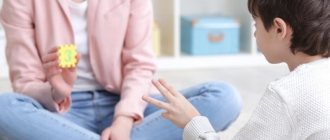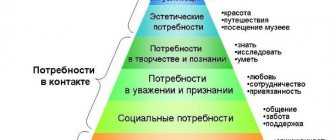As the child grows and develops, the scope of his capabilities constantly expands. Over time, he experiences a transition from primitive manipulations with objects to more conscious activities. Various types of leading activities in infancy can have a positive impact on the psychological development of the child and form him into a truly versatile and interesting person. Any changes that occur during this period of time have a strong impact on the formation of the baby and the process of developing his personality.
Definition and age periodization
The term “leading activity” was introduced into psychology by Vygotsky. This concept began to be understood as such activity, the development of which leads to the formation of the main psychological new formations at a given stage of personality development. For example, for a preschooler, role-playing game turns out to be the most important. With the transition to the next stage of psychological development, the leading activity changes, as the child develops new needs.
On this basis, an age periodization was compiled. It outlines the following stages:
- Infancy. Up to one year old, infants need emotional communication with adults.
- Children 1-3 years old. The leading type of activity at an early age is actions with objects.
- Preschool childhood. Role-playing games come to the fore for children aged 3-7 years.
- Younger schoolchildren (from 7 to 11 years old) are involved in educational activities.
- For teenagers from 11 to 15 years old, personal communication with friends becomes extremely important.
- Boys and girls aged 15-18 are busy with professional self-determination.
Time frame
So, do only the epithets “small” and “helpless” characterize a child at the stage of infancy? If we talk about age limits (up to 1 year), then yes. Infancy is the period of a child’s life between two crises: the first month and the first year of life.
- The crisis of the first month is characterized by the baby’s adaptation to life outside the womb. There is a crisis of physical separation of the little man from his mother.
- The crisis of the first year in psychology is associated with the development of walking and speaking skills.
Soviet scientist, psychologist L.S. Vygotsky identified age periods precisely along the boundaries of crisis stages. However, he believed that during a crisis, not only negative changes occur (disturbances in sleep, nutrition, behavior), but also, undoubtedly, positive ones: the child acquires a new skill that is significant for him, which makes it possible to develop at a new level. There is a change in the little personality.
Does a baby acquire such a skill in the first month of life? Physically, no. Psychologically - yes. He learns to perceive himself as a being living separately from his mother. Accordingly, he will continue to learn everything that contributes to his adaptation in social, everyday, mental, and emotional terms.
Based on all this, the boundaries of infancy are from 2 months to a year. This is the so-called stable period when the baby develops without a crisis. After this, the child moves to a new stage (early childhood), which by the age of 3 will also end in crisis: the child recognizes himself as an independent part of society, an independent and significant person.
In infancy, the baby’s leading type of activity is direct emotional communication with close people around him. At the same time, the baby is completely dependent on the adult: physical development, daily routine, proper nutrition, timely treatment, cognitive, motor, speech skills - he receives all this from his mother and develops with her help, through her example.
Communicate more with your baby. At this stage, the child’s need for emotional contact with his mother is extremely high. Your gentle voice, lullabies, nursery rhymes, and smiles give him the feeling of calm and comfort necessary for full development.
Characteristics of leading activities
Leontyev and Elkonin were engaged in in-depth study of developmental psychology. They emphasize that at all stages of development, the child is involved in various types of activities (communication, work, study, etc.). Personal preference certainly plays a role too. However, the most significant developmental effect on children is exerted by activities leading for a given age. In the process of practicing it, the child:
- mental processes are restructured;
- new psychological characteristics develop;
- other types of activities are being formed.
Let's consider the listed characteristics in more detail. Thus, the leading type of activity at an early age (1-3 years) is object-based activity. Toddlers learn to manipulate toys and real things around them. As a result of this, sensory standards and intelligence are formed in the form of visual and effective thinking. The child learns to place a small cube on a large one and insert a prism into the corresponding hole in the sorter.
By studying the purpose of objects, the child interacts with an adult. Gestures and emotional exclamations are no longer enough to convey information. This leads to the appearance of an important new formation - active speech.
The leading type of activity at an early age is the basis for the emergence of self-awareness. The child begins to separate the result of his actions with objects from the result of the actions of other family members. This is how the idea of oneself as a separate person is formed. All this leads to a crisis of 3 years.
In the course of manipulations with toys and objects, playful and productive (drawing, designing, modeling) types of activities are gradually formed. The prerequisites are being created for the transition to the next age stage.
Needs of a baby 1-3 years old
A young child is entirely dependent on an adult. He cannot satisfy his needs on his own. In addition, the baby needs the love and attention of its parents and communication with them. But at the same time, the baby can do a lot himself. He walks confidently and is able to pick up things he couldn’t reach before. He develops a desire for independence.
The contradiction that has arisen is resolved through the leading type of activity at an early age. Briefly, it can be described as the practical joint interaction of a baby and an adult with objects.
Babies begin to explore toys and things at about 6 months. They shake the rattle, knock it, press buttons, feel it with their hands and lick it. These actions are aimed at studying the physical properties of an object. At an early age, the child is more interested in its purpose. However, a baby cannot learn the correct actions with objects without the help of an adult. He does not have enough experience to independently understand the purpose of a pencil, spoon or comb. A leading activity at an early age is the opportunity to partner with mom or dad.
An adult acts as a mentor who shows socially developed methods of action, but does not carry them out for a fee. A situation of business communication is created. The baby, on the one hand, receives the necessary attention, and on the other, learns to act independently.
6.4. Crisis of three years
The three-year crisis is characterized by the fact that personal changes occurring in the child lead to changes in his relationships with adults. This crisis arises because the child begins to separate himself from other people, is aware of his capabilities, and feels himself a source of will. He begins to compare himself with adults, and he involuntarily has a desire to perform the same actions as them, for example: “When I grow up, I will brush my teeth myself.”
At this age, the following traits appear: negativism, stubbornness, devaluation, obstinacy, self-will, protest-rebellion, despotism. These characteristics were described by L.S. Vygotsky. He believed that the emergence of such reactions contributes to the emergence of a need for respect and recognition.
Negativism
manifests itself in a negative reaction to an adult’s demand or request, and not to the action itself. For example, a child ignores the demands of one family member or teacher, while obeying others. It was also noted that negativism mainly manifests itself in relationships with relatives, and not with strangers. Perhaps subconsciously the child feels that such behavior towards his family will not cause him serious harm. Therefore, we must remember that negativism and disobedience are two different things.
Another characteristic of the three-year crisis is stubbornness.
Its reason is not the child’s desire to get what he wants or demand at any cost, but that his opinion is taken into account. It doesn’t matter to the child whether he gets this thing or not, he needs to establish himself in his “adulthood”, in the fact that his opinion also means something. Therefore, a stubborn child will insist on his own even if he does not really need this thing.
The next characteristic is depreciation
— is inherent in all crises. It manifests itself in the fact that all habits and values that were previously dear begin to depreciate. For example, a child may throw and even break a previously beloved toy, refuse to comply with previously accepted rules of behavior, now considering them unreasonable, etc.
Obstinacy
is directed against accepted norms of behavior in the family and is similar to negativism and stubbornness. For example, if it is customary in the family to have dinner together, then the child begins to refuse to eat at this particular time, and then he develops an appetite.
Self-will
is expressed in the child’s desire to do everything himself.
If in infancy he strived for physical independence, now his behavior is aimed at independence of intentions and plans. This behavior manifests itself not only in the actions offered to adults, for example: “Do it yourself,” “You are already big and can do it,” etc., but also in the persistent desire to do this and not otherwise. This feeling captures the child to such an extent that he openly contrasts his desires with the expectations of others. The manifestation of independence is reflected in relationships with adults. When a child realizes that he can do something on his own,
he does not need adult help. They must understand this and try to avoid negative statements on this matter, not criticize the child, but allow him to show independence.
Protest riot
is expressed in frequent quarrels between children and parents. According to L.S. Vygotsky, “the child is at war with others, in constant conflict with them” (Vygotsky L.S., 1991).
Manifestations of despotism
are as follows: the child begins to dictate to everyone around him how to behave, and strives to be listened to and acted as he says. Such behavior can occur when the child is alone in the family or the last one.
Development of subject activity
A small child does not immediately understand the purpose of toys and things around him. It all starts with the first phase of development of the leading type of activity. At an early age, these are any actions with objects arising from their properties. Pencils can be rolled, thrown, licked, or tapped like drumsticks. Children act as experimenters.
Then comes the second phase, when the child learns the true purpose of the object and uses it in the usual way. The kid takes a pencil when he wants to draw. And finally, the turn of the third phase comes. The child masters the free use of an object, while constantly remembering its main function. So, playing doctor, the baby can use a pencil instead of a thermometer.
Characteristics of objective action
The difference between object actions and simple manipulations with objects is that object actions involve the use of objects in accordance with their purpose. The objects with which a child acts are created by people and created for a specific purpose: A person eats with a spoon, drinks from a cup, digs with a shovel, puts a hat on his head, and shoes on his feet. These are common use cases.
The method of using the items is not marked on them. The child cannot “open” it on his own. This happens only under the guidance and example of adults.
The relationship between action and object.
The objects that surround the child and with which he learns to act differ from each other in appearance, in use and, most importantly, in how and how firmly a specific purpose is attributed to them.
A significant part of the objects in their actual design “bear” their purpose. These are primarily objects that serve to influence other objects and materials. These include a spoon, fork, comb, hammer, shovel, pencil, brush and many others. This also includes clothes, shoes, dishes, various containers (boxes, drawers, cabinets) and so on. The structure and purpose of objects in some types of toys are very closely related: nesting dolls, pyramids, which are used for disassembly and assembly. (They are called collapsible toys).
Other items may serve different purposes due to their design and appearance, but their use is governed by rules that cannot be broken. For example, a towel, handkerchief, napkin and duster may be very similar, but you should not use a towel to blow your nose. There are also items that can be used in different ways depending on the circumstances. These are sticks, building materials and some toys.
From manipulations with objects, the child moves on to objective actions. Manipulations take into account only the external properties of things, regardless of their purpose: the child rolls everything round, knocks everything hard, squeezes everything soft. Now he/she must learn to use any object as required by adults.
Mastery of objective activity begins with establishing a connection between the object and its goal. This connection is established through direct teaching or imitation from adults. First, children begin to understand what an object is used for, and then they master the “technique” of using it.
Mother combs Andrei's hair with a brush. She then hands him the brush, brings his hand with the brush to her hair, and they go through the hair combing steps together. Now Andrey goes to the mirror and sees a comb, takes it properly by the handle, brings it to his head and makes several movements through or against his hair. Very often he touches the hair with the back of the brush, although, of course, no combing occurs. (From the observations of D.B. Elkonin).
In the second year of life (and until about the middle of the third year), children learn to use most of the simple objects around them. This leads to a close connection between action and object: each object is used for its intended purpose by the child. The difference between the attitude towards an object when the child is still manipulating and when he has mastered the object activity can be seen in the following examples, which show how children of different ages use a handkerchief.
Tanya puts the scarf on the floor and straightens it; takes it by the ends and puts it on the head; covers wooden mushrooms with it; puts it in his pocket, takes it out and puts it in the mushroom; touches different parts of the face with a handkerchief; makes rubbing movements over the face (“wipes”); makes rubbing movements on the chair (“wipes off the dust”), (from the observations of R. Lekhtman-Abramovich).
Third graders were given handkerchiefs and asked to use them as towels, napkins, and table rags. As a rule, the children refused to do this.
Seryozha (2.10.0). When asked to wipe the table with a handkerchief, he replied: “You can’t be a weakling. Just a handkerchief for me and my doll,” (From the observations of V.Ya. Kislenko).
The connection between an action and an object also lies in the fact that any action known to a child can only be performed with an object intended for him.
When two-year-old children who already knew how to use a comb and a cup were asked to “comb their hair” with a stick or “drink” from a cube, they could not. They also can't just show you how to comb your hair or drink with your hand without an object.
By the end of infancy, the connection between an action and an object becomes more free: the child knows what the object is used for, but can use it in another way. He can also show how to perform an action without an object or with an inappropriate object ("combing" with a stick or hand). This “separation” of action from object is a necessary condition for the emergence of a game.
Types of actions with objects
The leading type of activity in early childhood is the basis for the intellectual, speech and psychological development of the baby. Two types of actions with objects are of greatest importance: correlative and instrumental.
The goal of the former is to bring objects or their parts into predetermined spatial relationships. The child assembles a nesting doll, selects lids for jars, and puts parts into the holes. In doing so, he must take into account the sizes, shapes or colors of objects. It is impossible to master correlative actions without contact with an adult. The baby independently strings the rings of the pyramid in any order; he has not formed a reference pattern and the need to follow it. Playing together with your mother makes you want to assemble the toy correctly.
Tool actions suggest that the baby learns to handle an object in the way that is accepted in society. He must adapt his movements to the characteristic features of the thing (digging with a shovel, painting with a brush, wiping with a towel). Thus, the leading activity of a young child leads to the formation of elementary logic. Initially, the baby carries the spoon to his mouth along the shortest path, like a cookie or cracker. But over time, he realizes that this is how the soup is spilled. The spoon must be kept horizontal at all times. First, it is lifted up above the plate, and then brought to the lips.
- 6.1. Social development situation
- 6.2. Development of the child’s cognitive sphere
- 6.3. Personal formations
- 6.4. Crisis of three years
- 6.5. The leading activity in early childhood
Topic 6. EARLY CHILDHOOD (FROM 1 YEAR TO 3 YEARS)
6.1. Social development situation
Early childhood
– this is a period from 1 year to 3 years. At this age, changes occur in personal development, the cognitive sphere, and the social situation of development.
Neoplasms of infancy lead to changes in the relationship between the child and the adult, which in turn leads to the formation of a new social situation of development, which consists in the emergence of joint activities of the child and the adult,
and also in the fact that this activity becomes
substantive.
The essence of joint activity is the assimilation of socially developed ways of using objects, that is, an adult teaches the child how to properly use surrounding objects, and also explains what they are needed for and where they should be used. The social situation of a child’s development at this age looks like this: “Child – OBJECT – Adult.” As can be seen from this triad, the subject is important for the child. You can verify this by watching how a child plays: he constantly looks at the object he is passionate about, be it a car, a chair, a doll, a spoon, etc. There may be a feeling that he does not need anything else and no one needed, his attention is focused only on the object of passion. But this is not so, because without an adult a child cannot master human ways of using objects.
Joint activity becomes objective, because the motive of this activity lies in the object itself and the method of its use. Communication at this age takes the form of organizing objective activities. In other words, it occurs at the moment of explaining the correct use of a particular item. Communication develops intensively and becomes verbal, because mastering objects using only emotional coloring cannot be effective.
6.2. Development of the child’s cognitive sphere
At this age, perception, thinking, memory, and speech develop. This process is characterized by the verbalization of cognitive processes and the emergence of their arbitrariness.
Development of perception
is determined by three parameters:
perceptual actions
(the integrity of the perceived object),
sensory standards
(the emergence of sensation standards: sound, light, taste, tactile, olfactory) and
correlation actions.
In other words, the process of perception consists in identifying the most characteristic qualities, signs, and properties of a given object or situation; drawing up a certain image based on them; correlation of these standard images with objects of the surrounding world. This is how the child learns to divide objects into classes: dolls, cars, balls, spoons, etc.
From one year on, the process of learning about the world around us begins to actively develop. A child aged from one to two years uses various options to perform the same action, and from one and a half to two years he has the ability to solve a problem by guessing (insight), i.e. the child suddenly finds a solution to this problem, avoiding trial and error method.
From the second year of life, the child’s perception changes. Having learned to influence one object on another, he is able to foresee the outcome of a situation, for example, the possibility of pulling a ball through a hole, moving one object with the help of another, etc. The child can distinguish shapes such as circle, oval, square, rectangle, triangle, polygon; colors – red, orange, yellow, green, blue, purple.
Thanks to the development of perception, by the end of early childhood the child begins to develop mental activity. This is expressed in the emergence of the ability to generalize, transfer the experience gained from initial conditions to new ones, in establishing connections between objects through experimentation, memorizing them and using them in solving problems. A one and a half year old child can predict and indicate the direction of movement of an object, the location of a familiar object, and overcome obstacles on the way to achieving the desired goal. And after a year and a half, the reaction of choosing an object appears based on the most striking and simple characteristics: shape and color.
In early childhood, the development of thinking continues,
which from the visual-effective gradually turns into the visual-figurative, i.e. actions with material objects are replaced by actions with images. The internal development of thinking proceeds in this way: intellectual operations develop and concepts are formed.
Visual and effective thinking appears by the end of the first year of life and remains dominant until 3.5–4 years. At first, the child can abstract and highlight shape and color, so when grouping objects, he first of all pays attention to the size and color of the object. At the age of about two years, he identifies objects based on essential and non-essential features. At 2.5 years old, a child identifies objects according to essential characteristics: color, shape, size.
A feature of thinking in early childhood is syncretism. Syncretism
means incomprehension: a child, solving a problem, does not identify individual parameters in it, perceiving the situation as a holistic picture. The role of the adult in this case is to isolate and analyze individual details from the situation, from which the child will then identify the main and minor ones.
Visual-figurative thinking appears at 2.5–3 years and remains dominant until 6–6.5 years. The formation of this thinking is associated with the formation of elementary self-awareness and the beginning of the development of the ability for voluntary self-regulation, accompanied by a developed imagination.
Memory development.
By the age of two, a child develops working memory. Easy logic and thematic games are available to him, he can draw up an action plan for a short period of time, and does not forget the goal set a few minutes ago.
Speech development.
By the age of one year, a child can already call things by their proper names. He has a wealth of experience in understanding the world around him, he has formed an idea of \u200b\u200bparents, food, the environment, toys. And yet, of the many qualities contained in a word as a concept, the child first assimilates only individual properties characteristic of the object with which this word was initially associated in his perception.
A one-year-old child reacts to words as to the situation as a whole. The word turns out to be associated with the situation, and not with the object representing it. The child carefully observes the facial expressions and gestures of the speaking adult, catching from them the meaning of what is being said.
From 11 months, the transition from pre-phonemic to phonemic speech and the formation of phonemic hearing begins, which ends by the age of two, when the child can distinguish words that differ from each other by one phoneme. The transition from prephonemic to phonemic speech lasts 3 years and ends in the fourth year of life. At the age of 3, the child learns to correctly use cases, first begins to use one-word sentences, then, at the age of 1.5 to 2.5 years, he can combine words, combining them into two-three-word phrases or sentences of two words, where there is also a subject and predicate. Then, thanks to the development of the grammatical structure of speech, he masters all cases and is able to construct complex sentences with the help of function words. At the same time, conscious control over the correct pronunciation of speech utterances arises.
After 1.5 years, activity in independent speech and verbal communication is noted. The child begins to ask himself the names of objects or phenomena that interest him. First, he uses the language of gestures, facial expressions and pantomimes or a pointing gesture, and then a question expressed in verbal form is added to the gesture. The child learns to control the behavior of other people using speech. But a child aged 2.5 to 3 years cannot follow the instructions of adults, especially when it is necessary to choose one action from several; he will be able to make this choice only when he is closer to 4 years old.
During the second year of life, the child begins to assimilate the verbal designation of surrounding objects, and then the names of adults, the names of toys, and only then - parts of the body, i.e., nouns, and by the age of two, with normal development, he understands the meaning of almost all words related to the surrounding reality . This is facilitated by the development of semantic function
children's speech, i.e. determining the meaning of a word, its differentiation, clarification and assignment to words of generalized meanings that are associated with them in the language.
By the age of 2, children have a clear understanding of the purpose of the household and personal hygiene items around them. They understand general questions that require a yes or no answer.
At about 3 years old, the child begins to listen carefully to what adults are talking about and loves having stories, fairy tales, and poems read to him.
By the age of 1.5 years, a child learns from 30 to 100 words, but rarely uses them. By the age of 2 he knows 300 words, and by 3 – 1200–1500 words.
The following stages have been identified in the development of speech:
1) syllables (instead of words);
2) words-sentences;
3) two-word sentences (for example, “mom here”);
4) sentences of three or more words;
5) correct speech (grammatically consistent sentences).
The main trends in the development of speech of a young child are as follows.
• Passive speech is ahead of active speech in development.
• The child discovers that every object has its own name.
• At the border between the 2nd and 3rd years of life, the child intuitively “discovers” that the words in a sentence are related to each other.
• There is a transition from the polysemy of children's words to the first functional generalizations built on the basis of practical actions.
• Phonemic hearing is ahead of the development of articulation. The child first learns to listen to speech correctly and then to speak correctly.
• Mastery of the syntactic structure of the language is carried out.
• The functions of speech develop, a transition occurs from the indicative (indicative) to the nominative (denoting) functions of speech.
6.3. Personal formations
In early childhood, along with the development of the cognitive sphere, personal development also occurs. First of all, personal socialization
child, because, observing adults, he tries to imitate them: to do as they do, to behave as they behave in certain situations. The process of imitation occurs through communication and interaction between an adult and a child. Thus, observing people’s behavior and imitating them becomes one of the main sources of a child’s personal socialization. The sense of attachment, which is formed in a child by the end of the first year of life and continues to develop in early childhood, also plays an important role in the development of personality. The reason for attachment may lie in the fact that adults satisfy the child’s basic needs, reduce their anxiety, provide safe living conditions and active study of the surrounding reality, and form the basis for normal relationships with people in adulthood.
When the mother is close to the child, he is more active and inclined to explore the environment. A positive assessment of a child’s actions and personal qualities by a parent creates in him a sense of self-confidence, faith in his abilities and capabilities. If a child is attached to his parents and they pay him the same, then he is more obedient and disciplined. If parents are friendly, attentive and strive to satisfy the child’s needs, then he develops a personal, personal attachment.
If a child is deprived of constant positive emotional contact with his mother or loved ones, then he will subsequently have problems establishing normal, trusting relationships with others.
develops in early childhood .
The development of self-awareness will lead to the formation
of self-esteem
(for more details on this, see 3.6).
The development of independence is noted .
The phrase “I myself” speaks best about its manifestation. The child no longer always wants to be helped. Having mastered walking, he finds barriers and obstacles for himself and tries to overcome them. All this gives the child pleasure and indicates that he is beginning to develop qualities such as willpower, perseverance, and determination.
At this age, many children become disobedient. When they are told that they cannot do this, they continue to do it their own way. This often happens due to children’s desire to understand the world around them as quickly as possible.
From the age of 1.5 years, the child begins to realize his capabilities and his own personality traits. A two-year-old child understands that he can influence people and achieve the desired goal.
Children begin to develop empathy
– understanding the emotional state of another person. You can observe how a one and a half year old child strives to console an upset person: he hugs him, kisses him, gives him a toy, etc.
The child develops a need to achieve success.
This need is formed in stages. First, the child begins to realize his successes and failures, then he can explain the successes and failures of other people, then he acquires the ability to distinguish tasks by degree of difficulty and assess the degree of development of his own skills necessary to complete a given task, and finally he can evaluate his own abilities and efforts. efforts.
Table 5
Main achievements in the mental development of a child from 1 to 3 years old
In table. 5 shows the achievements of the child’s mental development with which he approaches the crisis of three years.
6.4. Crisis of three years
The three-year crisis is characterized by the fact that personal changes occurring in the child lead to changes in his relationships with adults. This crisis arises because the child begins to separate himself from other people, is aware of his capabilities, and feels himself a source of will. He begins to compare himself with adults, and he involuntarily has a desire to perform the same actions as them, for example: “When I grow up, I will brush my teeth myself.”
At this age, the following traits appear: negativism, stubbornness, devaluation, obstinacy, self-will, protest-rebellion, despotism. These characteristics were described by L.S. Vygotsky. He believed that the emergence of such reactions contributes to the emergence of a need for respect and recognition.
Negativism
manifests itself in a negative reaction to an adult’s demand or request, and not to the action itself. For example, a child ignores the demands of one family member or teacher, while obeying others. It was also noted that negativism mainly manifests itself in relationships with relatives, and not with strangers. Perhaps subconsciously the child feels that such behavior towards his family will not cause him serious harm. Therefore, we must remember that negativism and disobedience are two different things.
Another characteristic of the three-year crisis is stubbornness.
Its reason is not the child’s desire to get what he wants or demand at any cost, but that his opinion is taken into account. It doesn’t matter to the child whether he gets this thing or not, he needs to establish himself in his “adulthood”, in the fact that his opinion also means something. Therefore, a stubborn child will insist on his own even if he does not really need this thing.
The next characteristic is depreciation
– is inherent in all crises. It manifests itself in the fact that all habits and values that were previously dear begin to depreciate. For example, a child may throw and even break a previously beloved toy, refuse to comply with previously accepted rules of behavior, now considering them unreasonable, etc.
Obstinacy
is directed against accepted norms of behavior in the family and is similar to negativism and stubbornness. For example, if it is customary in the family to have dinner together, then the child begins to refuse to eat at this particular time, and then he develops an appetite.
Self-will
is expressed in the child’s desire to do everything himself.
If in infancy he strived for physical independence, now his behavior is aimed at independence of intentions and plans. This behavior manifests itself not only in the actions offered to adults, for example: “Do it yourself,” “You are already big and can do it,” etc., but also in the persistent desire to do this and not otherwise. This feeling captures the child to such an extent that he openly contrasts his desires with the expectations of others. The manifestation of independence is reflected in relationships with adults. When a child realizes that he can do something on his own,
he does not need adult help. They must understand this and try to avoid negative statements on this matter, not criticize the child, but allow him to show independence.
Protest riot
is expressed in frequent quarrels between children and parents. According to L.S. Vygotsky, “the child is at war with others, in constant conflict with them” (Vygotsky L.S., 1991).
Manifestations of despotism
are as follows: the child begins to dictate to everyone around him how to behave, and strives to be listened to and acted as he says. Such behavior can occur when the child is alone in the family or the last one.
6.5. The leading activity in early childhood
, objective activity becomes dominant
which affects both mental development and communication with adults.
In infancy, activity is manipulative in nature: the child can repeat actions shown to adults, transfer the learned action to another object, and master some of his own actions. But when manipulating, the child uses only the external properties and relationships of objects. In early childhood, objects become for the child not just an object, but a thing that has a specific purpose and a specific way of use. The child tries to master more and more new actions of the subject, and the role of the adult is to mentor, cooperate, and help in difficult situations.
By manipulating an object at the end of infancy and at the beginning of early childhood, the child will never be able to understand its functions. For example, he can open and close a cabinet door an infinite number of times, but will never understand its functional purpose. Only an adult can explain why this or that thing is needed.
Mastering the purpose of an object does not guarantee that the child will use it only for its intended purpose, but what is important is that he will know how, when and where it should be done. For example, having learned that pencils are needed for writing and drawing, a child can nevertheless roll them around the table or build something with them.
At first, the action and the object are closely related in the child’s understanding. An example of this is the following fact: he cannot comb his hair with a stick or drink from a cube. But over time, the subject is separated from the action.
There are three phases in the development of the connection between an action and an object:
1) any actions can be performed with the object;
2) the item is used only for its intended purpose;
3) free use of an object is possible, but only if its true purpose is known.
D.B. Elkonin identified two directions for the development of substantive activity:
1. Development of action from joint with an adult to independent execution.
The path of development of action from joint to independent was studied by I.A. Sokolyansky and A.I. Meshcheryakov. They showed that at first the orientation, execution and evaluation of the action are under the control of the adult. This manifests itself, for example, in the fact that an adult takes the child’s hands and performs actions with them. Then a partial or joint action is performed, i.e. the adult begins it, and the child continues. Then the action is performed on the basis of demonstration and, finally, on the basis of verbal instructions.
2. Development of means and methods of orienting the child in the context of the action. It goes through several stages. The first stage consists of:
a) in the non-specific use of tools (manipulation of objects);
b) using an object when the methods of its use have not yet been formed, for example, a child understands what a spoon is for, but when eating he takes it very low;
c) mastering a specific method of use.
The second stage occurs when the child begins to perform actions in an inadequate situation. In other words, the action is transferred from one object to another, for example, a child, having learned to drink from a mug, drinks from a glass. There is also a transfer of action according to the situation, for example, having learned to put on shoes, the child tries to pull them on the ball.
The third stage is accompanied by the emergence of game action. Here the adult does not tell the child what to do, how to play or use an object.
Gradually, the child begins to correlate the properties of objects with operations, that is, he learns to determine what an object can best do, which operations are most suitable for a specific object.
The stages of formation of such fastenings were identified by P.Ya. Galperin. He believed that at the first stage the child varies his actions based not on the properties of the tool with which he wants to get the object he needs, but on the properties of the object itself. He called this stage “targeted trials.” At the second stage - “lying in wait” - the child finds an effective way of acting with an object and tries to repeat it. At the third stage - the “stage of obsessive intervention” - he tries to reproduce an effective method of influence and master it, at the fourth stage he discovers ways to regulate and change the action, taking into account the conditions in which it will have to be performed.
Correlative and instrumental actions are significant for mental development.
Correlating Actions
consist of bringing several objects into certain spatial interactions - for example, folding pyramids from rings, using collapsible toys, etc.
Gun actions
- these are actions in which one object is used to influence other objects. The child masters instrumental actions in the process of learning under the guidance of an adult.
It was found that instrumental actions can be an indicator of the intellectual development of children, and subject actions indicate the degree of their learning and the breadth of contacts with adults.
Towards the end of early childhood, play and productive activities arise in object-tool activity.
Table of contents
Adult as a model
Elkonin studied the objective activities of children in detail. He paid special attention to instrumental actions, since through their development the socialization of the child occurs. In the development of the leading type of activity at an early age, according to Elkonin, two directions can be distinguished.
The first is the gradual mastery of one or another action with the help of an adult. First, the mother takes the baby's hands and helps him make the required movements. Then he is allowed to do some of the actions on his own. Subsequently, showing or verbal instructions from the parents is enough for the baby.
Without a model of action demonstrated by an adult, learning is impossible. Elkonin noted the following patterns:
- A child learns to manipulate objects when an adult encourages him to do so by influencing his emotions. The main thing for the baby is to do something together with mom or dad, to imitate them. When an adult leaves the game, it can continue for a long time.
- The baby initially grasps the general meaning of the action, and then its technical side is improved. So, a one-year-old child runs a comb over his hair without even touching it.
- What is important for a child is not the final result, but the correct reproduction of the actions shown to adults. The pattern can be repeated after numerous attempts.
- By performing actions, the baby mentally identifies himself with an adult.
- Parents play several roles at once. They are role models, mentors, supervisors, and a source of moral support at the same time.
What's most important right now?
The most important need of a baby is the need for security, safety, and stability. It is extremely important to satisfy her as much as possible. After all, if a child does not feel safe from infancy, he will forget how to trust the world around him for the rest of his life and will distance himself from it. May become withdrawn or socially hostile. If a child experiences a lack of parental love, care, affection, attention to his desires, if he is abused in the family, he will grow up embittered and alienated.
Indeed, at this age, for a child, the world and the family have the same structure: everything that happens in the family happens in the world. That is why, if a child experiences a divorce from his parents at an early age, for him not only does the family collapse, but the whole world collapses.
In infancy, a child learns to communicate with others and expects help and support from them. He learns to trust others, forms his first attachments: first, looking for a response from any person, then learning to separate his own and others, then choosing the closest and most significant people as objects of his love.
It is during this period that a feeling of psychological comfort and harmony is much more important than satisfying natural needs. Indeed, with the help of this feeling, the child learns to perceive himself as a human being - a thinking, rational, spiritual being.
Second direction along Elkonin
Another direction in the scientist’s research is the study of the characteristics of children’s orientation in the area of mastered action. Elkonin examined in detail the three stages of formation of the leading type of activity at an early age. The psychology of the child is clearly visible at each stage, and the changes occurring in it are studied.
Thus, at the beginning of the first stage, the child manipulates an object, unaware of its purpose. Gradually he learns to perform the correct actions with it, but practical skills are not yet sufficiently developed. The baby understands that the spoon must be brought to the mouth, but cannot hold it horizontally. At the end of this stage, the child masters a specific way of acting with objects. A hard connection is established in his head. Children cannot use the studied item for other operations (drink from a cube, wipe the table with a handkerchief).
At the second stage of development, the child begins to reproduce mastered actions in non-standard situations. Transfer can be carried out to other objects (you can drink not only from a cup, but also from a glass) and situations (trying to dress a cat).
The third stage is marked by the appearance of game action. The child independently decides which operations are suitable for objects. He masters substitution. Now the cube can be an iron, a piece of bread, or soap. The candy will be replaced by a plasticine ball or pebble. In fact, kids are introduced to the first elementary symbols. This creates the preconditions for the development of imagination.
Emergence of other activities
Through manipulations with objects, the baby becomes involved in new relationships. The leading activity of a young child creates the prerequisites for the emergence of:
- Labor activity. The baby is interested in using a broom, wiping dust with a rag, watering flowers with a watering can, and making cookies from dough. Not all parents are ready to patiently teach their child these skills. If a child is removed from household chores, his self-esteem decreases and his motivation to work disappears.
- Gaming activity. First, the child manipulates the toys, repeating the movements of the mother: feeding the bear, rocking the doll. He doesn’t depict anything yet, but simply copies. Gradually the imagination develops. By the age of 3, children are able to reproduce the real actions of adults with the help of toys and substitute objects. At the same time, during the game the child comes to an awareness of the role he plays (cook, mother, hairdresser, driver).
- Productive activities (drawing, modeling). Initially, the baby simply explores the material, learns to scribble with a pencil, without trying to depict something meaningful. The turning point comes when he begins to guess real objects behind random shapes and lines. The kid first applies the strokes, and then joyfully looks for what happened. With the participation of an adult, he develops a desire to deliberately depict some light images.
End of infancy
By the end of the first year, the baby learns to separate himself from the surrounding society, to feel independent (after all, he now knows how to move and express himself, make decisions and achieve goals).
By this time, the child seems to be left without a control system: biological rhythms no longer control him, and new motor and speech skills have not yet been fully mastered as levers for freely controlling his behavior and orientation in the world around him.
Thus, by the end of the first year of life, the baby is going through a crisis stage, which will help him move to a new level of development, when speech and the ability to move independently will be the leading means of regulating activity. During this period, the child goes through a process of reverse development. It is characterized by affective emotions, disruption of biological processes and needs (sleep, nutrition), moodiness, tearfulness, touchiness, willfulness, and disobedience.
Having emerged from this crisis, the child will enter a new age period - early childhood. And how the crisis itself will proceed - its severity and duration - largely depends on the correct behavior of the parents. But this is perhaps a topic for another discussion.
Is everything so clear?
Most psychologists and teachers recognize the existence of a single leading type of activity at an early age. However, there are also opponents to this theory. They protest against generalization at any age. Leites pointed out that the concept does not take into account the personality of a particular child, his individual characteristics. Rubinstein, without denying the importance of games, named another important activity that determines the development of any preschooler: household activities. Imperceptibly, through everyday activities, the baby learns the rules of behavior and learns to communicate with peers.
Petrovsky doubted that it was possible to determine the leading type of activity of children. At an early age, they are especially susceptible to the influence of their environment. Therefore, different children may lead different types of activities depending on the level of development and social situation.
7.1. Social development situation
Preschool childhood
covers the period from 3 to 6–7 years. At this time, the child is disconnected from the adult, which leads to a change in the social situation. For the first time, the child leaves the world of the family and enters the world of adults with certain laws and rules. The circle of friends expands: the preschooler visits stores, the clinic, and begins to communicate with peers, which is also important for his development.
The ideal form with which a child begins to interact is the social relationships that exist in the world of adults. The ideal form, as L.S. believed. Vygotsky, is that part of objective reality (higher than the level at which the child is) with which he enters into direct interaction; this is the area that the child is trying to enter. In preschool age, the world of adults becomes this form.
According to D.B. Elkonin, the entire preschool age revolves around its center, around an adult, his functions, his tasks. The adult here acts as a bearer of social functions in the system of social relations (an adult - dad, doctor, driver, etc.). Elkonin saw the contradiction of this social situation of development in the fact that the child is a member of society, he cannot live outside society, his main need is to live together with the people around him, but he cannot realize this, since the child’s life passes in conditions of indirect, and not direct connection with the world.
The child is not yet able to fully participate in the life of adults, but can express his needs through play, since only it makes it possible to model the world of adults, enter it and play out all the roles and behavior patterns that interest him.
Raising a harmonious personality
Petrovsky insisted that the comprehensive development of a child cannot be achieved through one leading type of activity. At an early age, it is important to introduce the child to various spheres of human activity. Here is their list:
- Object activity with toys. They can be composite (construction set, matryoshka, puzzle) or movable (spinning top, tumbler, machine).
- Experimenting with sand, dough, water and other substances.
- Communication with adults.
- Games in a group of peers under the supervision and guidance of adults.
- Self-service, formation of instrumental actions (eating with a spoon, sweeping with a broom, digging with a dustpan).
- Fine art activities (appliqués, simple crafts, modeling, drawing).
- Getting to know music through listening, singing, dancing. Kids are very fond of musical toys, many like classical works.
- Perception of poems, fairy tales, looking at illustrations in books.
- Physical activity (gymnastics, outdoor games, cycling, running bike, etc.)
The leading type of activity at an early age is a controversial concept. However, it is impossible to deny the fact that babies’ attention is directed to objects. It is no coincidence that pots, brooms, and daddy’s tools become favorite toys. The task of parents is to encourage children’s independence and patiently teach them the correct actions with objects. The intellectual and psychological development of your beloved child depends on this.











